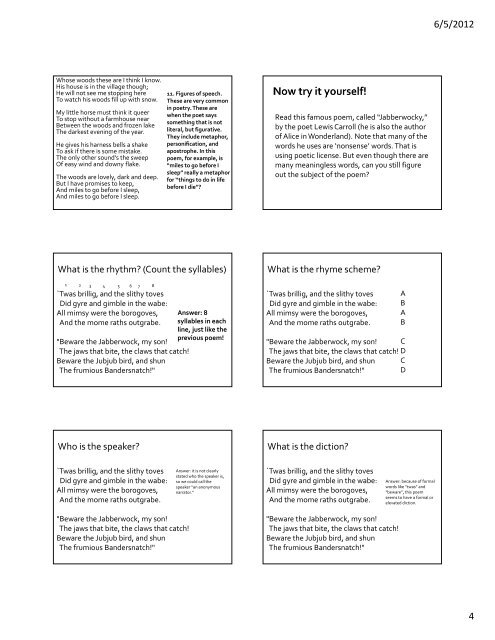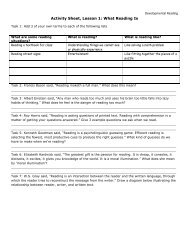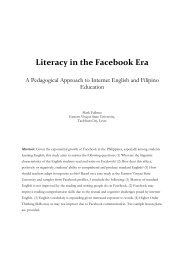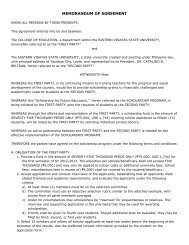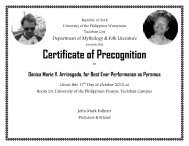PDF handout of the 32 Powerpoints - Mark Fullmer
PDF handout of the 32 Powerpoints - Mark Fullmer
PDF handout of the 32 Powerpoints - Mark Fullmer
Create successful ePaper yourself
Turn your PDF publications into a flip-book with our unique Google optimized e-Paper software.
6/5/2012Whose woods <strong>the</strong>se are I think I know.His house is in <strong>the</strong> village though;He will not see me stopping hereTo watch his woods fill up with snow.My little horse must think it queerTo stop without a farmhouse nearBetween <strong>the</strong> woods and frozen lakeThe darkest evening <strong>of</strong> <strong>the</strong> year.He gives his harness bells a shakeTo ask if <strong>the</strong>re is some mistake.The only o<strong>the</strong>r sound's <strong>the</strong> sweepOf easy wind and downy flake.The woods are lovely, dark and deep.But I have promises to keep,And miles to go before I sleep,And miles to go before I sleep.11. Figures <strong>of</strong> speech.These are very commonin poetry. These arewhen <strong>the</strong> poet sayssomething that is notliteral, but figurative.They include metaphor,personification, andapostrophe. In thispoem, for example, is“miles to go before Isleep” really a metaphorfor “things to do in lifebefore I die”?Read this famous poem, called “Jabberwocky,”by <strong>the</strong> poet Lewis Carroll (he is also <strong>the</strong> author<strong>of</strong> Alice in Wonderland). Note that many <strong>of</strong> <strong>the</strong>words he uses are ‘nonsense’ words. That isusing poetic license. But even though <strong>the</strong>re aremany meaningless words, can you still figureout <strong>the</strong> subject <strong>of</strong> <strong>the</strong> poem?What is <strong>the</strong> rhythm? (Count <strong>the</strong> syllables)1 2 3 4 5 6 7 8`Twas brillig, and <strong>the</strong> slithy tovesDid gyre and gimble in <strong>the</strong> wabe:All mimsy were <strong>the</strong> borogoves,And <strong>the</strong> mome raths outgrabe."Beware <strong>the</strong> Jabberwock, my son!The jaws that bite, <strong>the</strong> claws that catch!Beware <strong>the</strong> Jubjub bird, and shunThe frumious Bandersnatch!"Answer: 8syllables in eachline, just like <strong>the</strong>previous poem!What is <strong>the</strong> rhyme scheme?`Twas brillig, and <strong>the</strong> slithy tovesDid gyre and gimble in <strong>the</strong> wabe:All mimsy were <strong>the</strong> borogoves,And <strong>the</strong> mome raths outgrabe.ABAB"Beware <strong>the</strong> Jabberwock, my son! CThe jaws that bite, <strong>the</strong> claws that catch! DBeware <strong>the</strong> Jubjub bird, and shun CThe frumious Bandersnatch!" DWho is <strong>the</strong> speaker?What is <strong>the</strong> diction?`Twas brillig, and <strong>the</strong> slithy tovesDid gyre and gimble in <strong>the</strong> wabe:All mimsy were <strong>the</strong> borogoves,And <strong>the</strong> mome raths outgrabe.Answer: it is not clearlystated who <strong>the</strong> speaker is,so we could call <strong>the</strong>speaker “an anonymousnarrator.”`Twas brillig, and <strong>the</strong> slithy tovesDid gyre and gimble in <strong>the</strong> wabe:All mimsy were <strong>the</strong> borogoves,And <strong>the</strong> mome raths outgrabe.Answer: because <strong>of</strong> formalwords like “twas” and“beware”, this poemseems to have a formal orelevated diction."Beware <strong>the</strong> Jabberwock, my son!The jaws that bite, <strong>the</strong> claws that catch!Beware <strong>the</strong> Jubjub bird, and shunThe frumious Bandersnatch!""Beware <strong>the</strong> Jabberwock, my son!The jaws that bite, <strong>the</strong> claws that catch!Beware <strong>the</strong> Jubjub bird, and shunThe frumious Bandersnatch!"4


